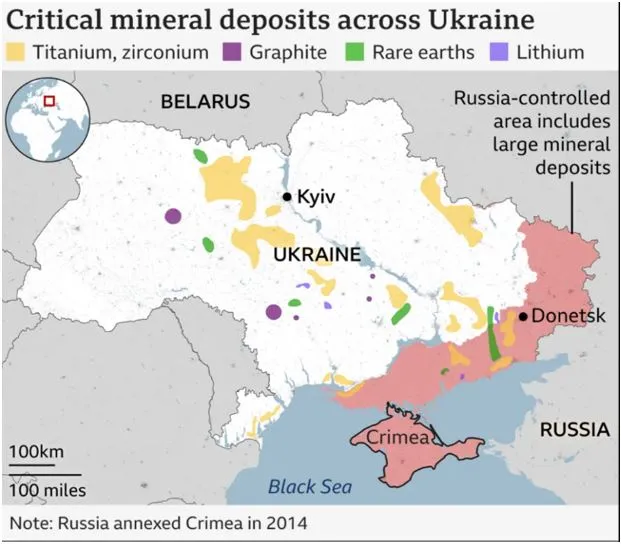

2nd May 2025 (10 Topics)
Context
The United States and Ukraine signed a landmark deal—called the US-Ukraine Reconstruction Investment Fund. This agreement gives Washington access to Ukraine’s rich reserves of critical minerals, and in return, helps fund Ukraine’s reconstruction and military support.
What exactly is this deal about?
- The agreement creates a joint investment fund between the US and Ukraine. This fund will help support Ukraine’s post-war economic recovery.
- In return, the US will get partial access and shared profits from future sales of Ukraine’s critical minerals like lithium, titanium, graphite, and rare earth elements.
- The partnership is based on a 50:50 revenue-sharing model.
- Ownership of Ukraine’s mineral resources remains with Ukraine, and the country retains the right to decide what and where to extract.
- Ukraine is not obligated to repay past US aid under this agreement.
- The deal also includes new US military assistance (e.g., air defense systems), although no formal security guarantees were offered.

What are ‘critical minerals’ and why are they important?
- Rare earths are a group of 17 metals used to make magnets that turn power into motion for electric vehicles, cell phones, missile systems, and other electronics. There are no viable substitutes.
- Critical minerals are naturally occurring elements that are essential to modern industries, especially in:
- Green energy: Used in electric vehicles (EVs), wind turbines, solar panels, and batteries.
- Defense: Important for missile systems, radar, drones, etc.
- High-tech electronics: Smartphones, laptops, semiconductors.
- Aerospace: Satellites, jet engines.
- The US Geological Survey (USGS) considers around 50 minerals as “critical,” including rare earths, lithium, nickel, cobalt, graphite, and titanium.
- These minerals are difficult to substitute, and their supply chains are concentrated—especially in China, which controls about 90% of global rare-earth production.
What minerals does Ukraine have, and where?
- Ukraine is rich in critical minerals. About 5% of the world's "critical raw materials" are in Ukraine. Ukraine has deposits of 22 of the 34 minerals identified by the European Union as critical:
- Lithium: Estimated 500,000 metric tons, used in batteries; deposits found in central and southeastern regions.
- Graphite: Around 20% of global reserves; key for EVs and nuclear energy.
- Titanium: Used in aerospace and defense; found in the northwest and central regions.
- Rare earth elements: Including neodymium, cerium, lanthanum, and others, essential for electronics and military tech.
- Nickel, cobalt, gallium, zirconium, beryllium, and scandium are also present.
- However, 40% of Ukraine’s mineral reserves (including some lithium and coal) are currently in Russian-occupied territory, making control and development challenging.
Critical Minerals in India
|
More Articles

